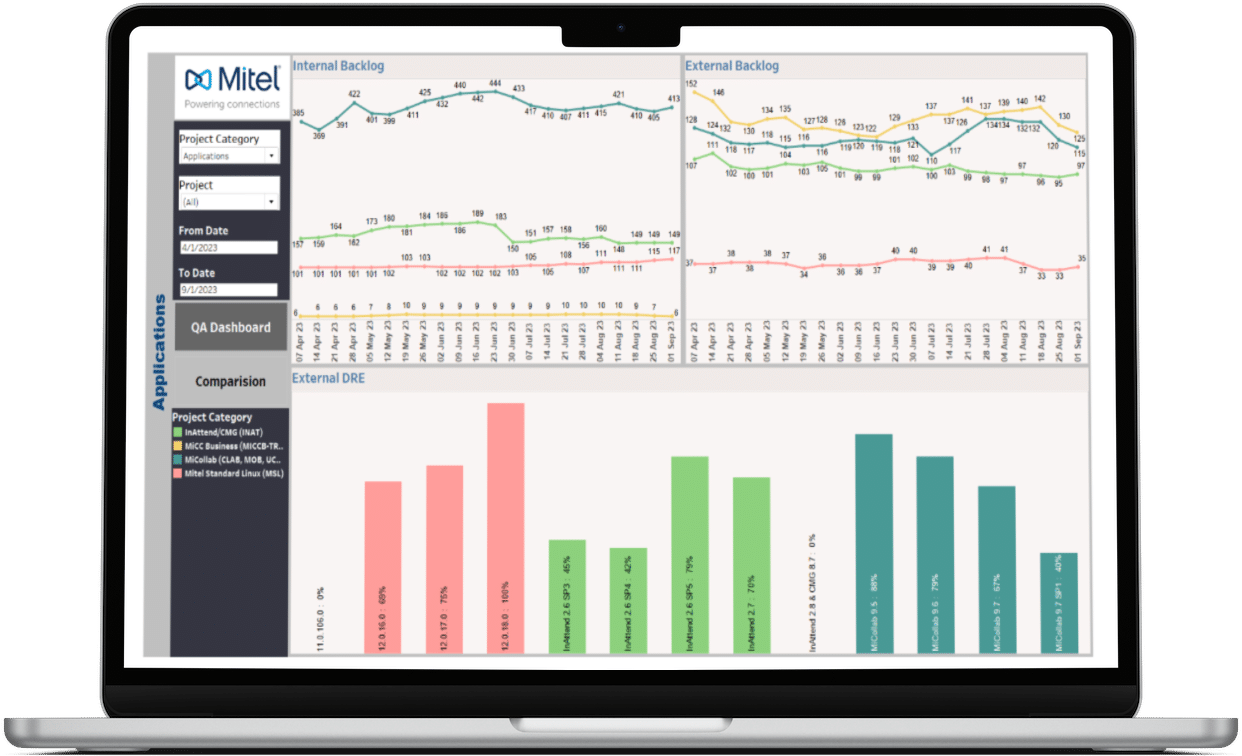Mitel
Enhancing Business Intelligence for a Telecommunications Company: A Mitel Case Study.
Telecommunications
Business Intelligence
2
Starting up & Scaling up

Introduction
Guided Solutions, a distinguished executive recruitment firm based in the United Kingdom, specializes in serving the food, beverage, and agribusiness sectors. With a commitment to providing customized recruitment solutions, Guided Solutions leverages their industry expertise and extensive networks to identify exceptional talent that aligns seamlessly with their clients’ requirements and organizational culture.
Business Objective
The primary objective of the project was to implement a customized Business Intelligence (BI) solution to replace the limited Jira gadget functionality. The client aimed to gain deeper insights into their operational data, track key performance indicators, and improve decision-making.
Project Scope
- The project scope included:
- Authenticating Jira APIs to access and retrieve the required data.
- Data processing and storage to ensure data quality and accessibility.
- Developing queries and procedures for data transformation and analysis.
- Creating customized reports to visualize trends, such as planned vs. actual features, internal bugs inflow/outflow, feature cycle time, and the distribution of work types.
- Optimizing data retrieval and processing performance to minimize query response times and ensure efficient resource utilization.
- Automating data fetching and visualization processes for ongoing efficiency.
Data Collection and Integration
Data collection and integration were pivotal aspects of the Mitel project, ensuring that data was accessible and suitable for analysis:
- Data Sources: The project sourced data from two primary channels:
- Jira: Data was fetched from Jira using authenticated APIs. This data encompassed various operational metrics and project-related information.
- Excel Spreadsheets: Additional data was collected from Excel spreadsheets, potentially containing supplementary information or data not available within the Jira environment.
- Data Integration: Data integration involved combining information from Jira and Excel sources into a unified dataset for analysis. Authentication procedures were established to access Jira APIs, and data processing was executed to ensure data quality, consistency, and reliability. This integration facilitated a comprehensive view of the client’s operational data.
Key Performance Indicators (KPIs)
- Key Performance Indicators (KPIs) were instrumental in tracking and evaluating the project’s success and impact on Mitel’s operations:
- Planned vs. Actual Features Completion: This KPI provided insights into the alignment between planned and actual feature completion, aiding in project management and resource allocation.
- Internal Bugs Inflow and Outflow: Tracking the inflow and outflow of internal bugs allowed Mitel to monitor the health of their systems and evaluate the effectiveness of bug resolution processes.
- Feature Cycle Time: This KPI measured the time taken for features to move through the development cycle, helping optimize development processes and project timelines.
- Distribution of Work Types: Analyzing the distribution of different work types provided valuable insights into resource allocation and project diversity.
BI Tools and Technologies
- The Mitel project leveraged a combination of BI tools and technologies to enhance data visualization and analytics:
- Custom Data Processing Scripts: Custom data processing scripts, likely developed using programming languages such as Python or JavaScript, were employed to retrieve, manipulate, and transform data from various sources. These scripts played a crucial role in automating data retrieval and preprocessing tasks, ensuring data readiness for analysis.
- Database Management Systems: Database management systems, such as SQL databases, were utilized to store and manage the processed data. These systems offered a structured and organized environment for data storage, ensuring data consistency and accessibility for reporting and analysis.
- Reporting Tools: The project involved the implementation of reporting tools designed to create customized reports and visualizations. These tools allowed for the representation of key performance indicators (KPIs) and data insights in a user-friendly and interactive format. Likely candidates for reporting tools include Tableau, Power BI, or other similar BI platforms.
Data Analysis and Insights
- Data collection and integration were pivotal aspects of the Mitel project, ensuring that data was accessible and suitable for analysis:
- Data Sources: The project sourced data from two primary channels:
- Jira: Data was fetched from Jira using authenticated APIs. This data encompassed various operational metrics and project-related information.
- Excel Spreadsheets: Additional data was collected from Excel spreadsheets, potentially containing supplementary information or data not available within the Jira environment.
- Data Integration: Data integration involved combining information from Jira and Excel sources into a unified dataset for analysis. Authentication procedures were established to access Jira APIs, and data processing was executed to ensure data quality, consistency, and reliability. This integration facilitated a comprehensive view of the client’s operational data.
- Data Sources: The project sourced data from two primary channels:


Challenges and Solutions:
- Challenges faced during the project included data integration complexities, data quality issues, and performance optimization. Solutions included:
- Developing robust data integration processes to handle diverse data sources.
- Implementing data validation and cleansing procedures to address data quality concerns.
- Tuning queries and optimizing data processing to enhance system performance.
- Implementing automation to streamline data fetching and visualization processes.
Conclusion
In conclusion, the implementation of a customized BI solution successfully addressed the client’s business objectives. The client now has access to comprehensive data insights, enabling them to make informed decisions and optimize their operations. By overcoming data integration challenges and leveraging automation, the project ensured ongoing efficiency and data-driven decision-making for the telecommunications company based in Ontario.






